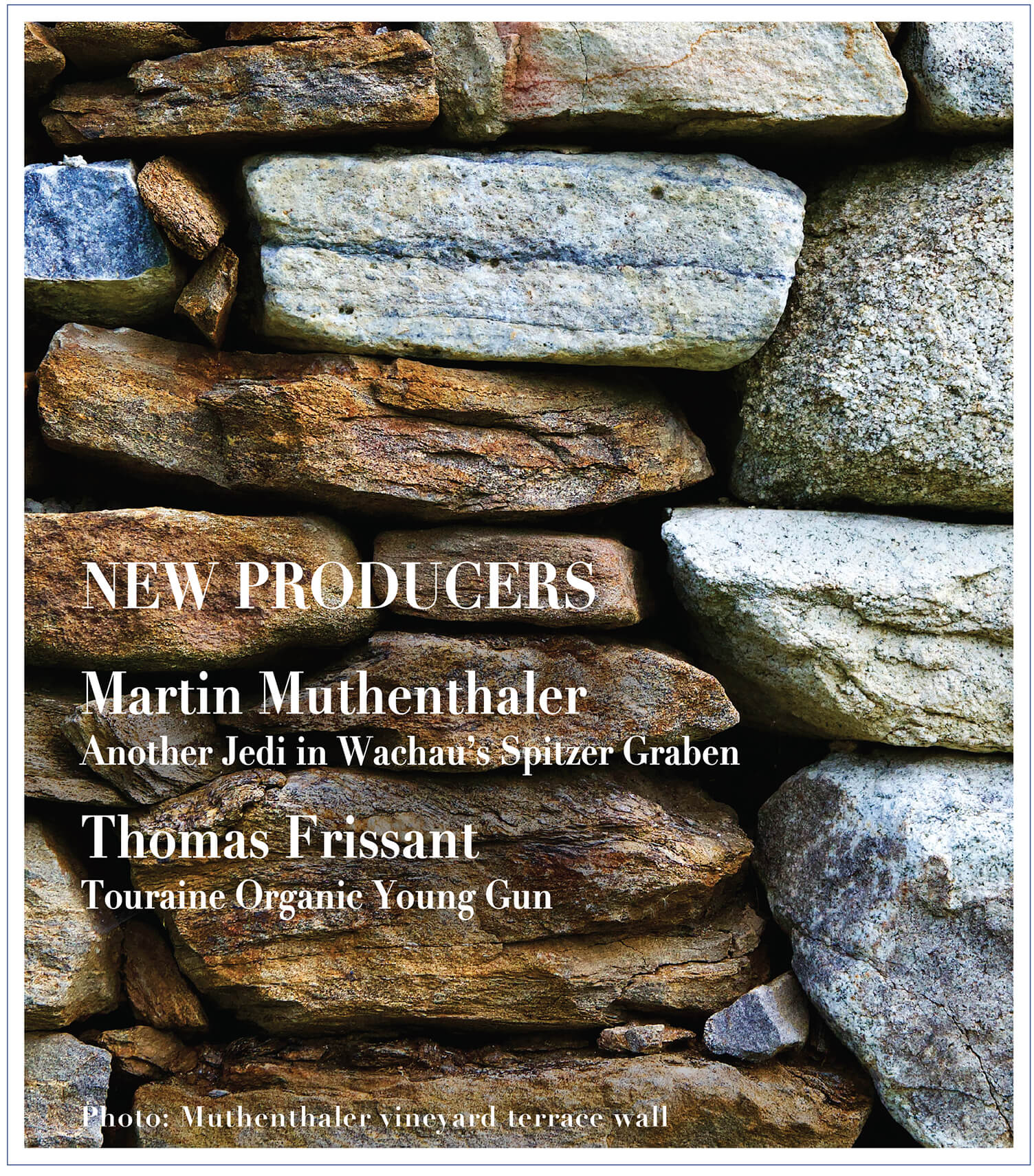



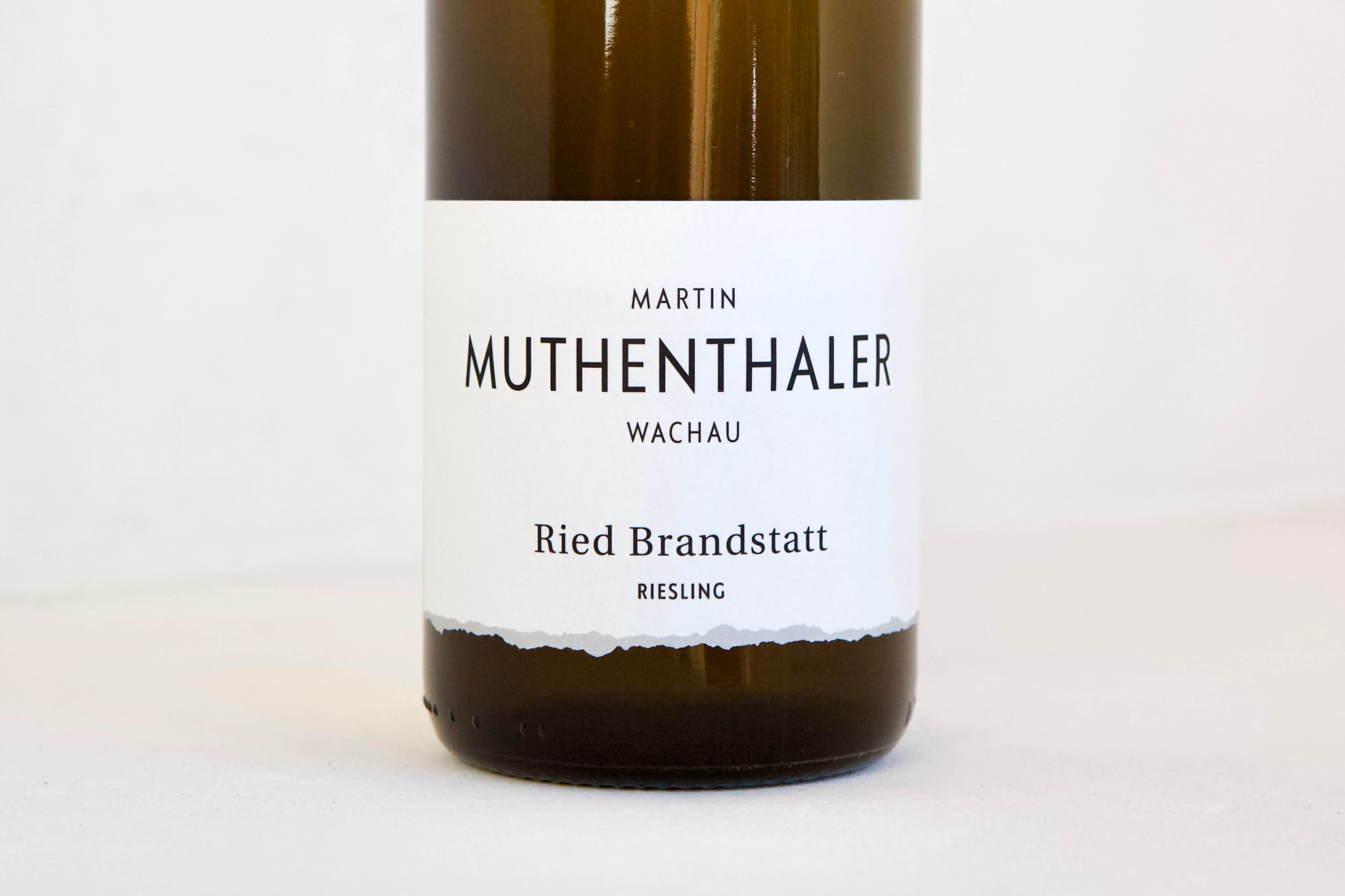
Our first encounter with Martin Muthenthaler in 2014 was at the same Vie Vinum table as our friend and Austrian wine wizard, Peter Veyder-Malberg. All who attended this wonderful biennial event had the fortune to taste the 2013 vintage from every top grower’s Austrian Riesling and Grüner Veltliner. 2013 remains a favorite since I started drinking Austrian wines in the late 1990s and took a deep dive at the start of 2000, followed by my first extended European trip that included Austria in June 2004. It was, and remains, a growing season whose wines express a sort of contained lightning, their exquisite balance and energy raising the hairs on our arms and necks, sometimes to the point of full-on goosebumps.
Every 2013 was charging, some oozing and flirting with perfection—a season of restrained wines that right away displayed all their jewelry elegantly. But at the big event, Peter who thus far seemed to be on his own planet suddenly had a friend, a vinous partner to share ideas, and the stage. Pouring next to him was the rosy-cheeked, smiling and energetic Martin, a stretched rail of a man without a gram of slack, made of wire and steel, with a handshake as firm as a marble sculpture. The wines tasted that day from his bottles offered no illusion: Martin’s ascent was imminent.
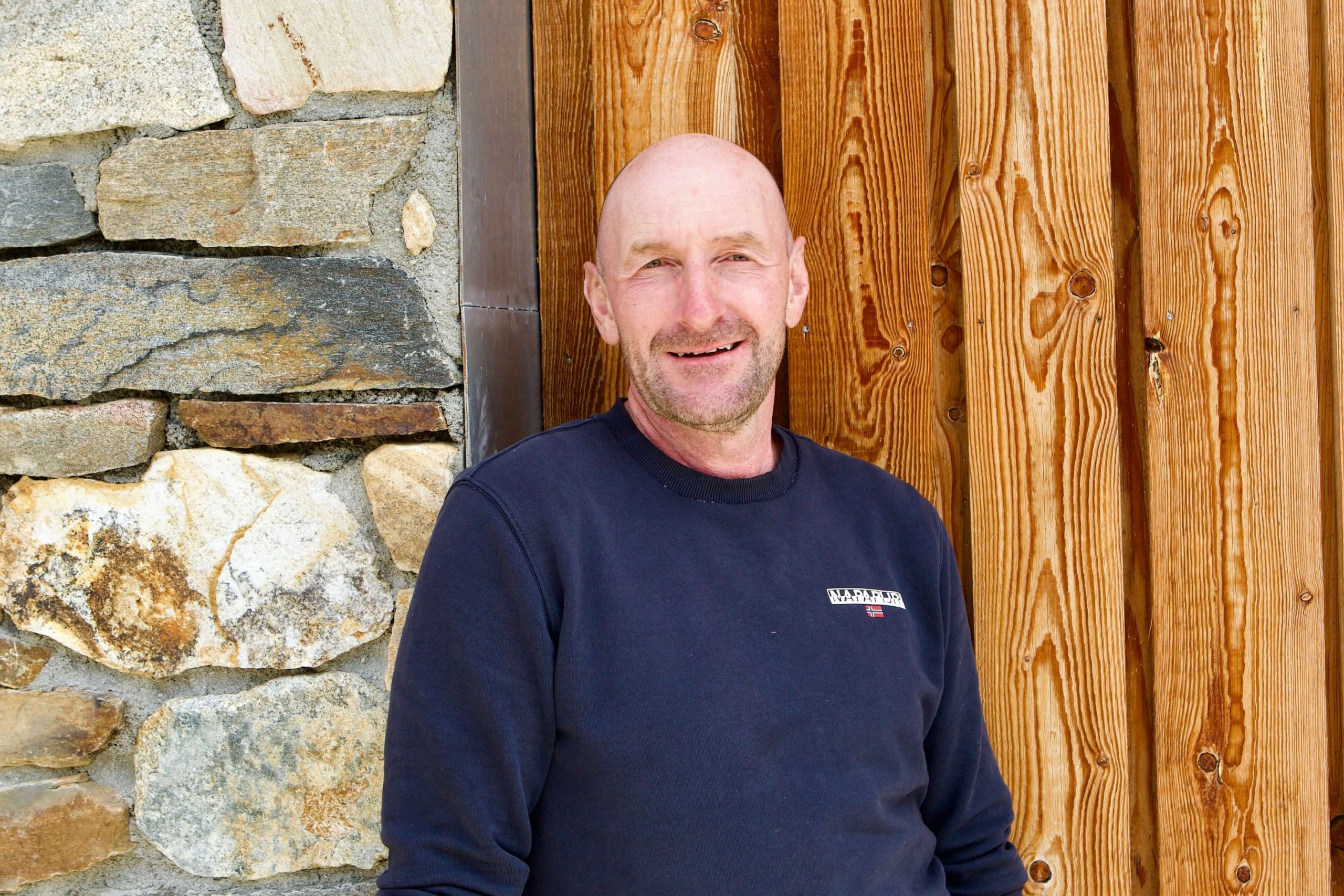

A former truck driver who bluntly claims with a certain level of pride that he was fired from his job, Martin returned in 2005 to his family’s tiny parcel of “Buschenschank,” deep into the Spitzer Graben. His collaboration with the Vinea Wachau lasted three years–until 2008, the same year a certain rebellious new arrival to the Spitzer Graben at that table in Vie Vinum harvested his first grapes just down the street …
The Spitzer Graben is the farthest west and the coldest section on the north side (left bank) of the Danube (Donau) River. In Martin’s earlier years, no one would pay attention to this deeper Spitzer Graben area away from the Danube. It was off the river into a notoriously frigid valley, which meant that mostly only lower levels of ripeness were achievable, and rarely found enough strength for the celebrated Smaragd wines without dehydrating grapes on the vine to increase the required higher alcohol levels to qualify for this highest classification of dry wine in the Wachau.
Martin’s return was the perfect moment to dig into the quiet Spitzer Graben, a section of the Wachau all but abandoned decades before that would eventually be recognized as a good investment in the face of climate change. With new global interest and demand for more soft-handed viticultural tactics, it was also the optimal moment to flow into the green side of the force instead of against it. Once a well-kept secret, the Spitzer Graben has become a focal point for taut expressions of Riesling and Grüner Veltliner. It’s only strange that in this mildew heaven, it was one of the first areas where organic farming recently took hold on the left bank of the Wachau. Everywhere else in the appellation—those warmer areas—it’s an easier thing to accomplish.


In the world of great stories exists the famous dynamic duos. In sports, Jordan and Pippen, Montana and Rice; in fantasy, Batman and Robin, Skywalker and Solo, Kirk and Spock. Shrek and Donkey? No one can say for certain who would be who between Martin and Peter. The two shared meals, the world’s greatest wines, and progressive ideas that fit their specific territory, offered help to each other and nurtured a meaningful friendship. With Peter’s greater exposure to a more global wine view and Martin’s open mind and talent in the vineyards and to similarly see fine details and relentlessly pursue them in his wines, things started to shift dramatically. With Peter blazing his global trail early on and finding worldwide acclaim and success, he still supported Martin’s achievements. Together, this duo contributed to the global attention of the Spitzer Graben, and other growers have started to find footing there too.
Martin describes all those years spending time with Peter as “a wonderful, synergetic togetherness.” While Peter is mostly reserved though with a small but slightly more extroverted side (he’d probably disagree with the latter), Martin is much quieter. He’s also less proficient in English, which makes him naturally more timid outside of German-speaking company. Whenever we’ve met at an informal event, he’s always smiling, covered in dirt and grass clippings from weed whacking, managing the vines and moving dirt, or building rock walls. His toil never seems to end, and I suspect that when exhausted, he lies like a corpse until the crack of dawn resurrects his consciousness. Even during our lunch with Melanie and Martin to finally agree on our partnership in the US after ten years of courtship he could hardly contain his desire to get back out to the vines. He seems half man, half machine. Today, however, he seems much more at ease with Melanie at his side.

Martin’s wines were brought to the US by a few different importers over the last decade or so. Back before that 2014 Vie Vinum showing, Martin’s previous Wachau wines were spirited but old-fashioned; rustic but clean—though it should be noted that the two previous years before 2013 were different seasons: stylistically fuller vintages overall which made it harder to recognize a breakthrough performance for anyone. At the time, it was easy to find Martin’s wines in the US market because his New York-based importer worked well. And what wines were shown at Vie Vinum were either just bottled or would be shortly. His 2013 wines hit a new level and though they were different they were undoubtedly on par with the best growers in the salon–a slam dunk. Today, they’re constantly M.J. launching from the free-throw line.

With his departure from the classical Wachau Smaragd style (riper, fuller, more concentrated, more baroque), he shifted focus to a freewheeling but conscious natural practice. Unrestrained by the Vinea Wachau, he focused on high biodiversity vineyard life that went well beyond the vine itself by focusing on the health of the dirt and vineyard canopy, and a different calibration of grape ripeness.
Martin eventually became an influential force for the unarguable quality of his wines. The world took notice, and so did other Wachau growers. With Martin and Peter and now another duo of younger growers turning heads with their similar vineyard culture and racy Spitzer Graben wines under the label, Grabenwerkstatt, this once-forgotten valley should be on every serious wine lover’s map.

While remaining Austria’s preeminent wine region now for generations, Wachau is also one of today’s slowest to embrace change. Other Austrian wine communities jumped much further ahead of Wachau and much earlier regarding conscious ecological viticulture and organic, biodynamic and natural farming. The exception is one of the world’s trailblazers, a sort of outlier in the Wachau on the south side of the river, the country’s most famous pioneering biodynamic family, the Saahs. They’ve practiced biodynamic farming since 1971 and are in the oldest known winery in Austria, Nikolaihof. They may also be Europe’s first fully committed commercial biodynamic winegrower. But the Wachau wasn’t always slow to change.
Imagine Austria, post-World War II defeated and destroyed—physically, mentally, spiritually. In Arnold Schwarzenegger’s compelling three-part Netflix documentary (worth watching for his candid historical and cultural narrative of Austria and the United States after WWII), “Arnold,” he talks a lot about Austrian men, like his father after the war, with his most memorable comment, “Austria was a country of broken men.” Like all sectors of Austria, the people in wine regions began to try to rebuild their wine country and culture with dignity. The remaining population had a difficult recovery because of political turmoil, including wine regions in Lower Austria, like Wachau, Kremstal, Kamptal and neighboring wine areas, that were under Russian occupation until 1955; other sectors were occupied by the US, France and England, and, similar to Berlin, Vienna was also divided between them.
The rebuilding of the country’s wine reputation had a slight hiccup and went from solid momentum to full wipeout in 1985. The Austrians shot themselves in the foot with the Glykolwein-Skandal, when it was discovered that glycol was added to some bulk wines to impart a richer taste. Few did it, but their entire export business suffered. No one died, but it became perhaps the most famous winemaking scandal in recent history. Even if in Italy one year later there was another scandal involving methanol poisoning where more than twenty people died, the Glykolwein-Skandal is still more famous. (Peter Veyder-Malberg told me that the global awareness of the Austrian problem was partly heightened because the scandal broke in the summertime with little other news to report, and because Australia made it a point to make sure everyone knew it was Austria, not them.) After the Italian’s wine scandal, their country’s wine exports dropped by 40%, though only for less than a year. Austrian exports dropped to zero. All products were pulled from every shelf worldwide. Austrian wines didn’t make a comeback until the early 1990s. The upside of the scandal was sweeping reforms and restrictions to Austrian wine production, making it perhaps the most reliably governed wine-producing country in the world. Today, few countries can challenge Austrian wines’ average quality and price.
Those who rebuilt wine regions like the Wachau did so during challenging economic times. After the war, the Allied-occupied territories continued to suffer because most of the agricultural output was under Russian control. In the accepted (albeit possibly revisionist) historical narratives of the time, the Russians took the crops home as reparations for the war instead of allocating them to other parts of Austria. Then, when those from the Wachau who established the trailblazing Vinea Wachau in 1983 (with a framework years in the making), it became difficult for many to continue to evolve in technique and approach to viticulture because they’d already produced such magnificent rewards. With Austrian wines significantly improved through stricter quality standards due to the Glykolwein-Skandal, the Vinea Wachau’s classifications of Steinfeder, Federspiel and Smaragd (akin to Kabinett, Spätlese, and Auslese, respectively), combined with the region’s dramatic wine country scenery and rich history, which earned it UNESCO World Heritage status in 2000, Wachau became Austria’s gold standard. They did everything right. Right? Well, almost.
The challenge of today’s current Wachau generation (those who are publicly in charge) is still under the watchful eye and controlled purse strings of their parents–the rebuilders. The rebuilders are the ones who saw and felt those harder times and toiled firsthand with their parents to rebuild opportunities for their children. Understandably, older generations are risk averse when faced with what they may view as unnecessary changes that could compromise their crops, which, of course, may compromise their economic agenda: if it ain’t broke, don’t try to fix it—a familiar inner family power struggle. What was missing from the Vinea Wachau codex was a proactive plan for protecting nature; they didn’t place importance on balanced biodiversity and industry-leading ecological measures that would set the standard even higher—to be a true global leader ahead of its time. But we have to hand it to the Wachau trailblazers, they did so many things right, though they were slow to come around to ecological consciousness. Perhaps they just needed a few nudges as much from the inside as the outside. Maybe the guys making noise with their organic farming, including those in that backwater Spitzer Graben rocked the boat enough with the quality and selling prices of their wines to influence the region’s greater culture.
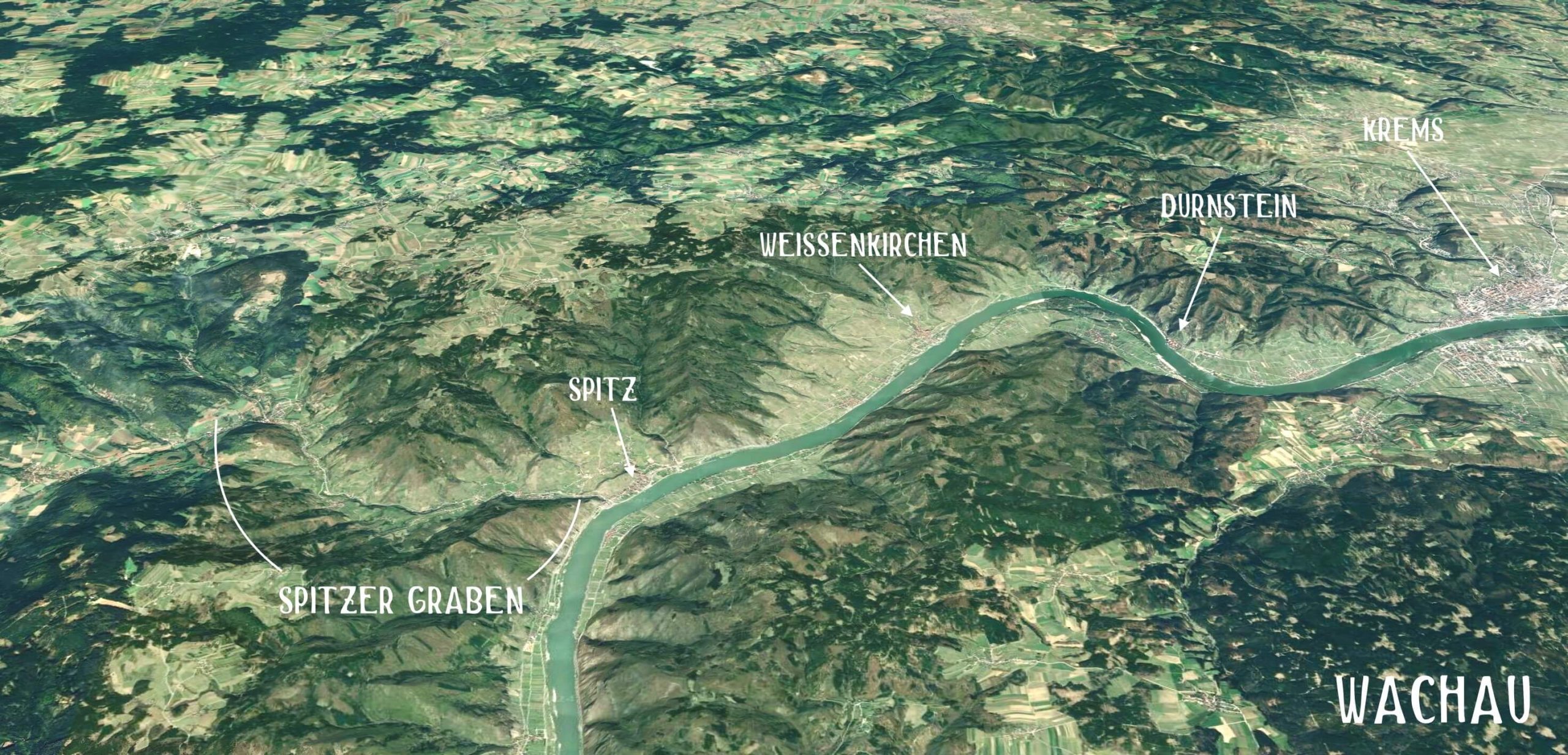

Once in the path of the Danube before tectonic movements altered the course of the river, the steep, east-to-west running Spitzer Graben splits off from the river at the far western end of the Wachau where it turns north in about four kilometers. Here, Martin farms organically and does almost all of the vineyard work himself–at least until his Bavarian wife, Melanie, jumped in headfirst in 2021, also taking charge of restructuring their sales, marketing, and communications.
Without the assistance of outside consultants in the cellar but drawing on many years of exchange and collaboration with other growers and his great friend and winegrowing neighbor, this garagiste gifted with a green thumb and well-honed palate and nose crafts a range of Riesling and Grüner Veltliner of sterling precision and quality which now have few equals in Austria.

While Martin’s wines are a notable departure from the Wachau style, they still express the flavors and aromatic nuances associated with Grüner Veltliner and Riesling inside of Austria; this is to say that while they’re international in some ways, there’s no mistaking their origin. Typically, Martin’s wines are intense. Their core is dense and their architecture lacks fluff and fat—just like their maker: straight to the point, few curves, tight angles.
One particularly compelling attribute of his Grüner Veltliners is that they are much closer in structure and feel to Riesling than most others. Another fabulous quality (due to the skill of the grower) is that even warmer vintages still taste and feel like colder ones, at least when they’re young.

Martin’s approach in the cellar allows each terroir to best express itself inside his range by being treated more or less the same through vinification and aging processes. Of course, some exceptional moments require a break from the parameters, but they are generally in this line.
Grüner Veltliner grapes are immediately pressed over an eight-hour cycle, tank settled for 12 hours, and then undergo spontaneous natural fermentation with maximum temperatures of 18 to 22˚C. Spitzer Graben is aged in steel, whereas all the others are in medium-sized oak vats, where they continue to age for 10 months. Malolactic rarely happens but is not inhibited. The first sulfites are added a month after fermentation and the wines are lightly filtered before bottling without fining.
Riesling grapes are macerated for up to eight hours, depending on the ripeness (with riper grapes receiving less time), pressed over an eight-hour cycle, tank settled for 12 hours, and then undergo spontaneous natural fermentation with maximum temperatures of 18 to 22˚C. For ten months before bottling, Brandstatt ages in 320-liter steel vats, Bruck in 700- to 1000-liter steel, and Stern in 700-liter acacia. Malolactic rarely happens but is not inhibited. The first sulfites are added a month after fermentation and the wines are lightly filtered before bottling without fining.

Martin’s small organic certified plots inside these rather large, classified vineyards range in altitude of a couple hundred meters. Though they are generally variations of south-southwestern faces, this means great diversity and variation of formations, aspects and exposures. What rock and soil type he finds in his parcels may not be congruent with what is recorded by the general geological surveys published in 2014 (read here) nor what the Vinea Wachau shares on their website. It lacks details for entire vineyards of importance, like Brandstatt, to growers like Muthenthaler, Veyder-Malberg, and Grabenwerkstatt so we’ll leave it to the growers. It should be noted that Martin is the only commercial grower in the Spitzer Graben working solely with local fruit. Altitudes and aspects from analyses by the Muthenthalers and Google Earth.
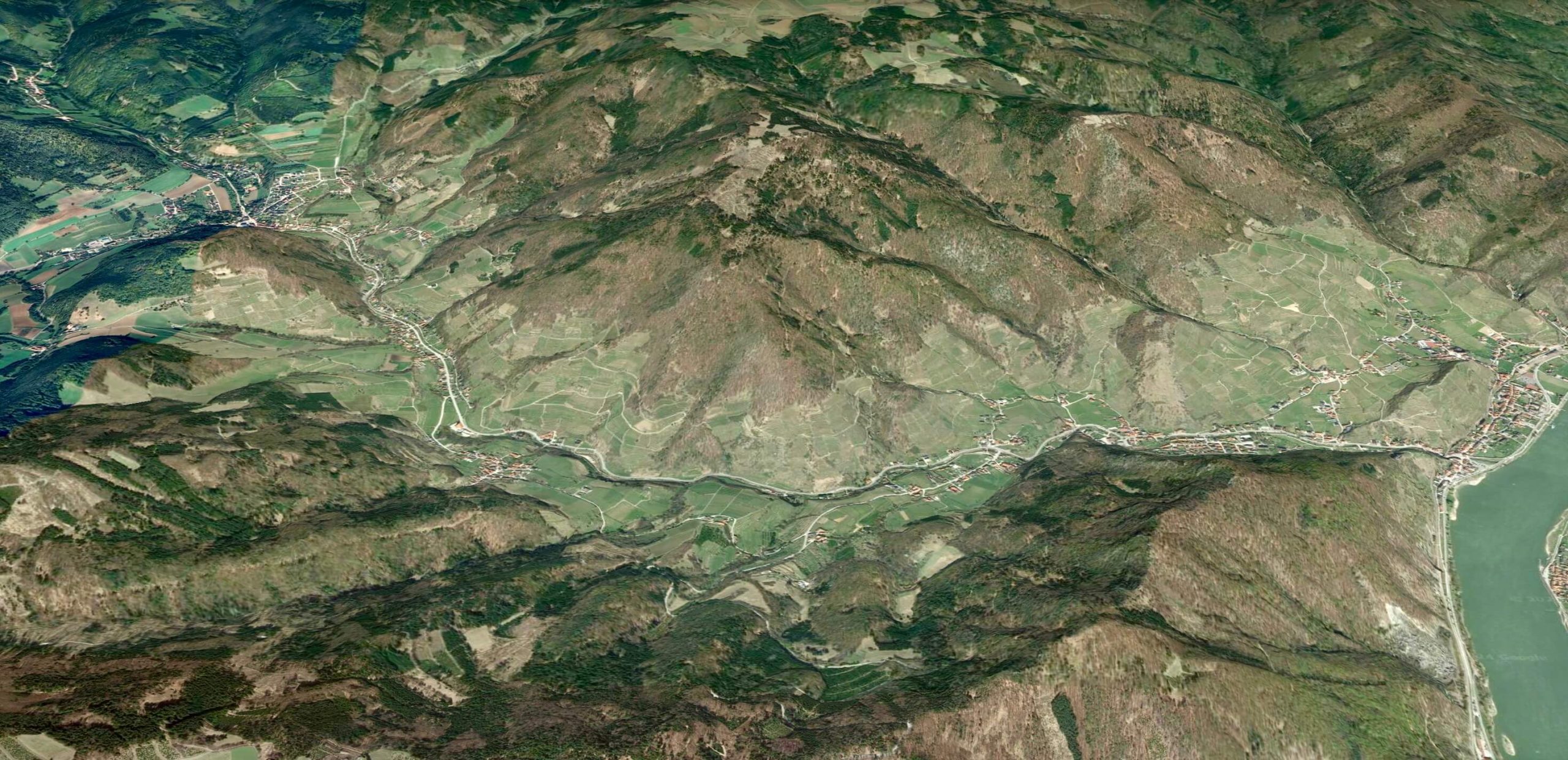
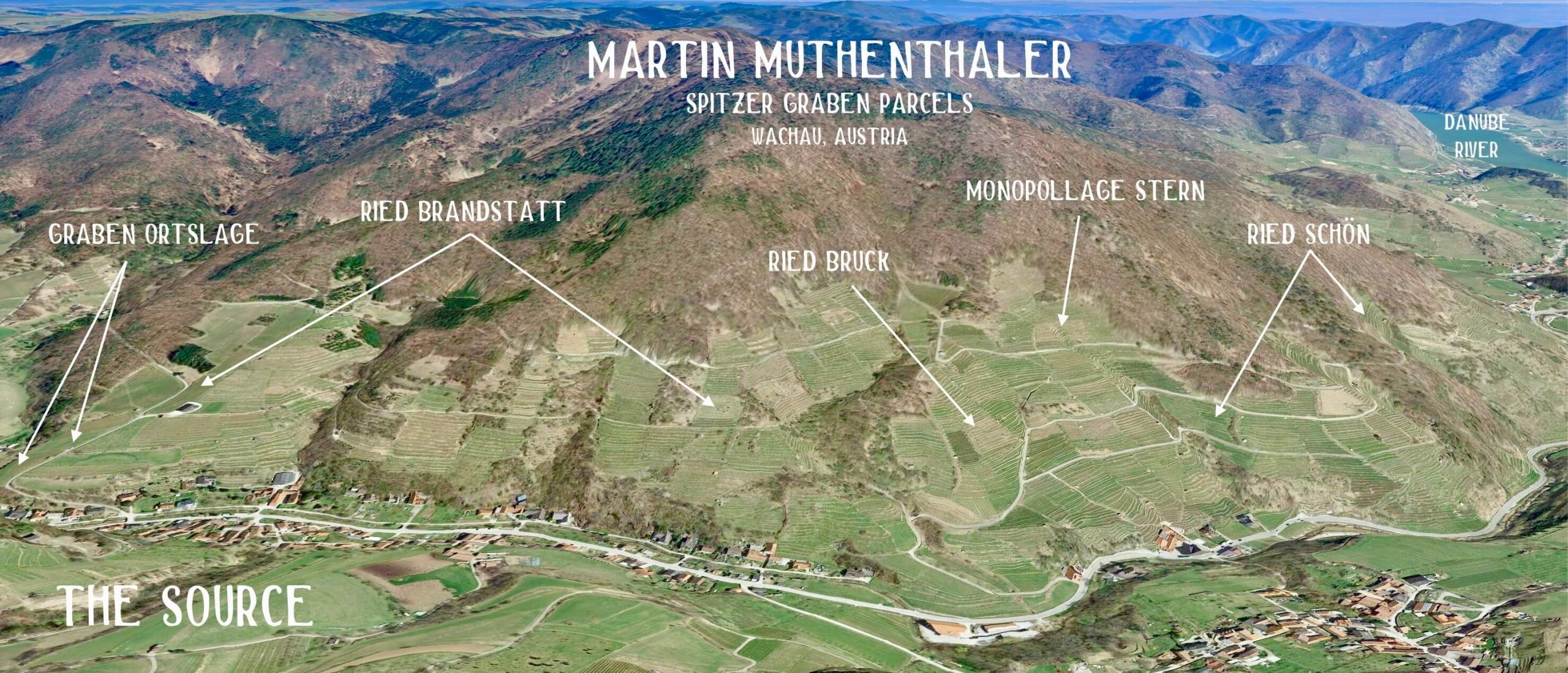
For a more extensive research and commentary on Wachau and what rock’s got to do with it, read further below, “Deeper Wachau Dirt.”
Grüner Veltliner ‘Spitzer Graben’ is the largest production wine in Martin’s range and represents the fresh and pointed effect of this cold valley’s wines when picked around a potential alcohol of 12%. The grapes are the first pick of the season from many vineyards planted between 1980 and 2017. The altitudes range between 320 to 400 meters with south/southwest exposures on mostly very steep terraces propped up by rock walls. The thin topsoil is rich in organic matter mixed with rock and sand derived from the underlying bedrock of gneiss, mica schist and other metamorphic rock formations, like amphibolite, paragneiss, and quartzite, and maybe some loess.
Planted in 2000, Martin’s two parcels for his Grüner Veltliner Ried Schön sit between 350 and 400 meters on extremely steep terraces, one with a west face on the main hill, and the other southeast. The thin topsoil is 20 cm deep and rich in organic matter with a rock and sand topsoil derived from the underlying bedrock of gneiss. (According to the Vinea Wachau website, “The impressive terraced Schön site is in the immediate vicinity of the Ried Bruck. Instead of the granodiorite gneiss of the Ried Bruck and amphibolite, paragneiss predominates in the Schön. In addition, the soils are deeper and richer in nutrients. The profile shows vineyard soil from a higher terrace on scree. The matrix is clayey, with paragneiss stones embedded in it.)
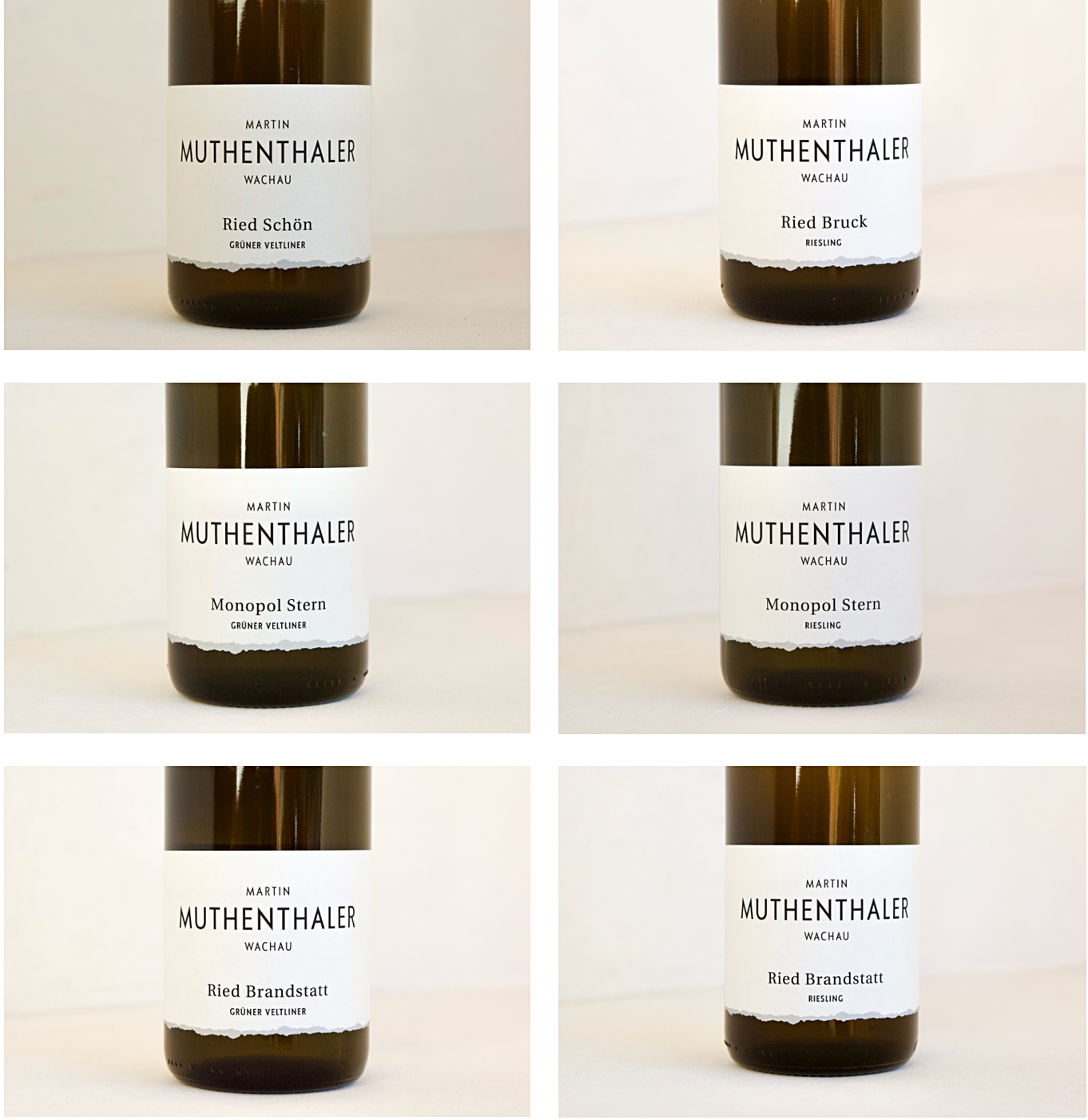
A subsection in the upper terraces of Bruck, is Martin’s Monopollage Stern. His Grüner Veltliner was planted by his great-grandfather in 1950 and are his oldest vines, and the Riesling was planted in 1989. At 410 to 450 meters, they are also on extremely steep terraces on a south exposure set closest to the forest, which stimulates a faster cooling effect in the summer and more contact with nature for a greater influence of biodiversity. The meager 10 cm deep topsoil is rich in mostly organic matter with little rock and sand derived from the underlying bedrock of mica schist. Regardless of the grape, Stern is a beam of light, fresh and pure; a capture of the essence of this challengingly high altitude, steep, rocky, and cold site inside this verdant valley.
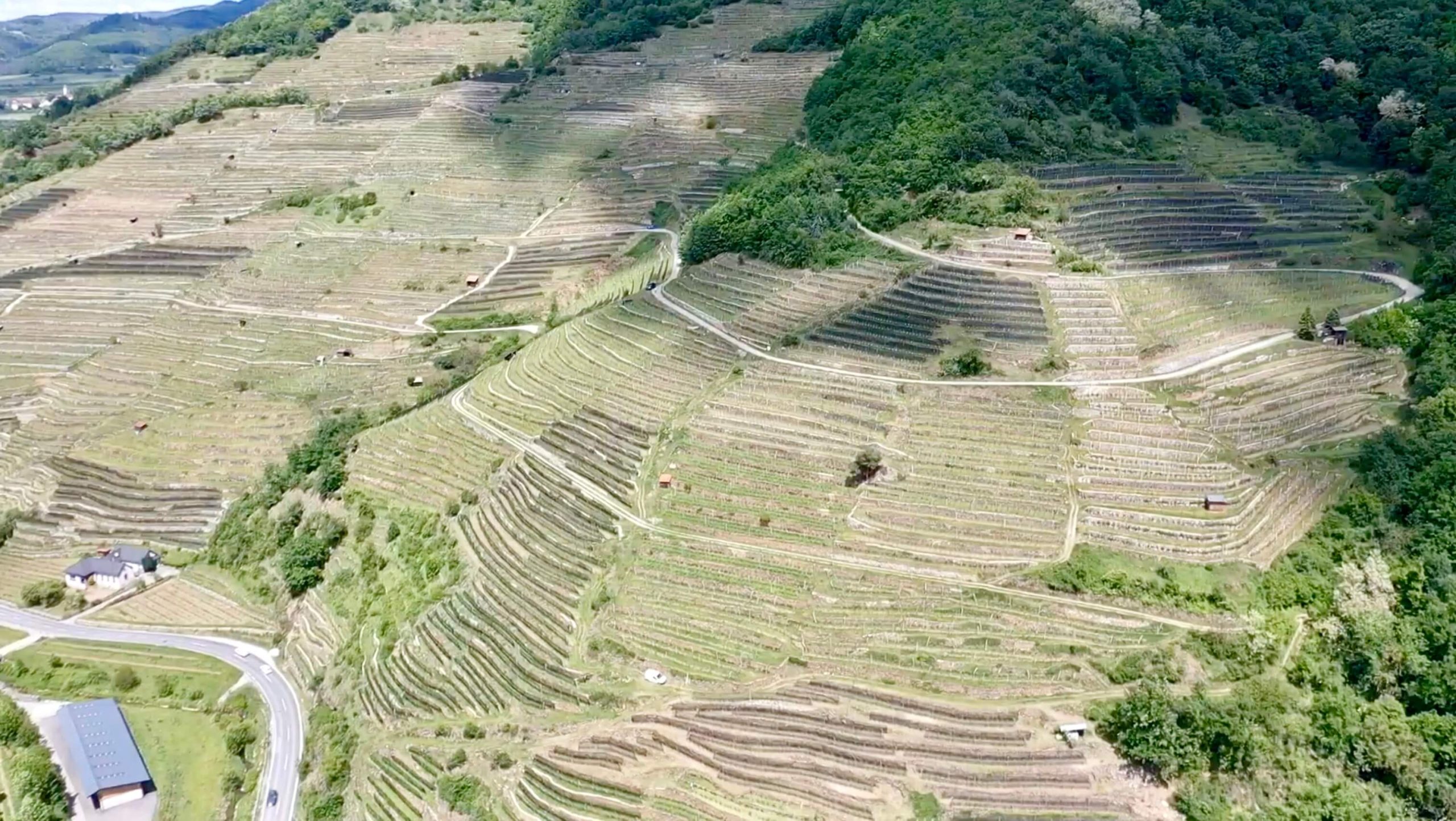
Riesling Ried Bruck was planted in 1990-2005 in the Wachau’s Spitzer Graben where it sits at 370 to 385 meters of altitude on extremely steep terraces with south-southwest exposure. Though the Vinea Wachau’s assessment of this large and diverse 17-hectare vineyard ranging from 292 to 488 meters says it’s principally composed of granodiorite gneiss, amphibolite, with quartz and feldspar-rich subvolcanic rock, Martin’s parcel has thin sandy and rocky topsoil derived from an underlying bedrock of mica schist. (According to the Vinea Wachau’s website, “The acidic Spitzer granodiorite gneiss of the Ried Bruck in the western Wachau is the counterpart to the Gföhler gneiss in the east. It is often associated with dark, basic amphibolite. The soils are practically free of loess and lime, so the pH values are neutral to slightly acidic. The sandy soil was formed by weathering from Spitzer granodiorite gneiss and amphibolite. A high proportion of stone (in the coarse soil) contains both rocks. Due to rearrangement processes on the slope, the material finally came to lie on Spitzer granodiorite gneiss. The weathered gneiss is interspersed with a quartz and feldspar-rich dike rock, an aplite.)
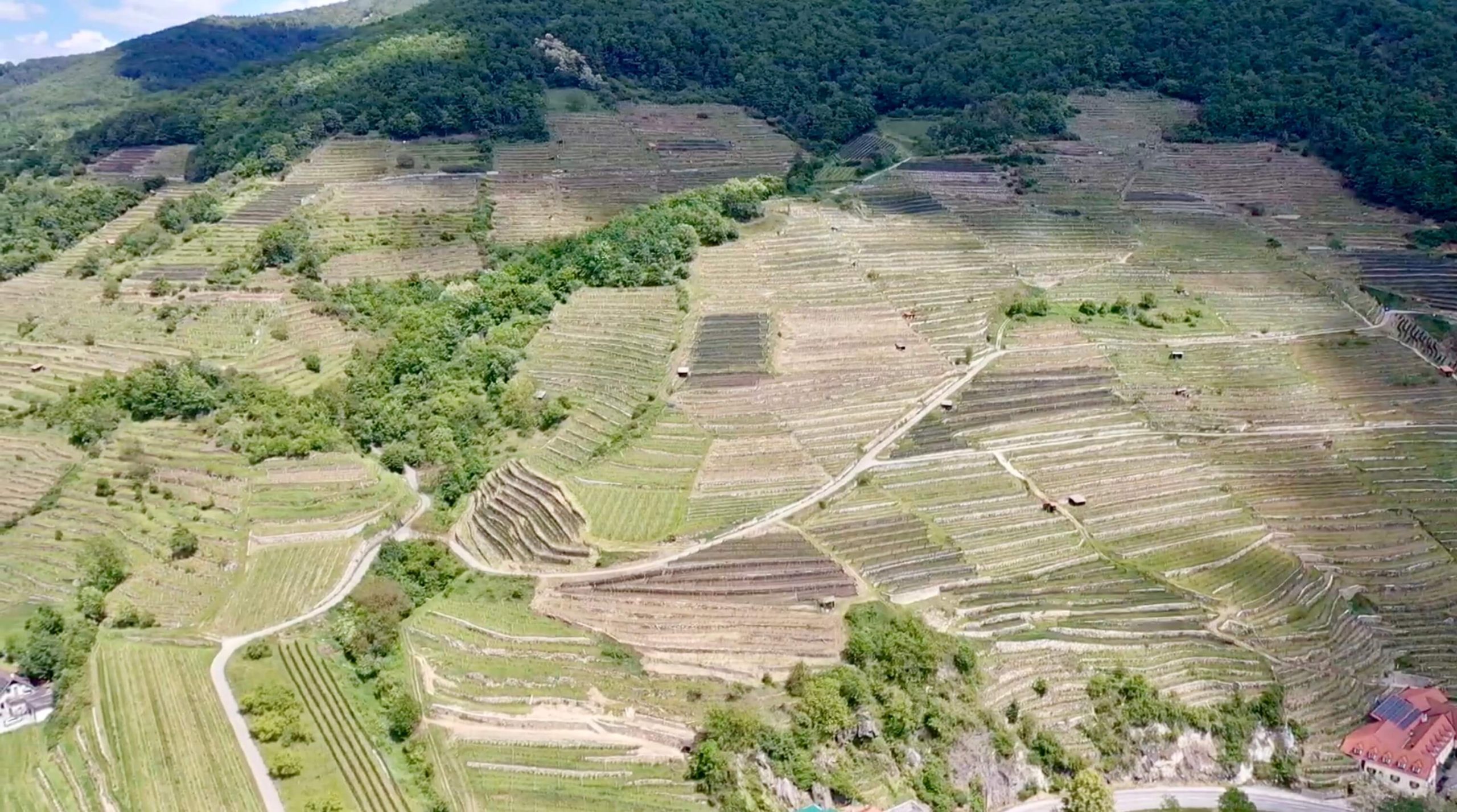
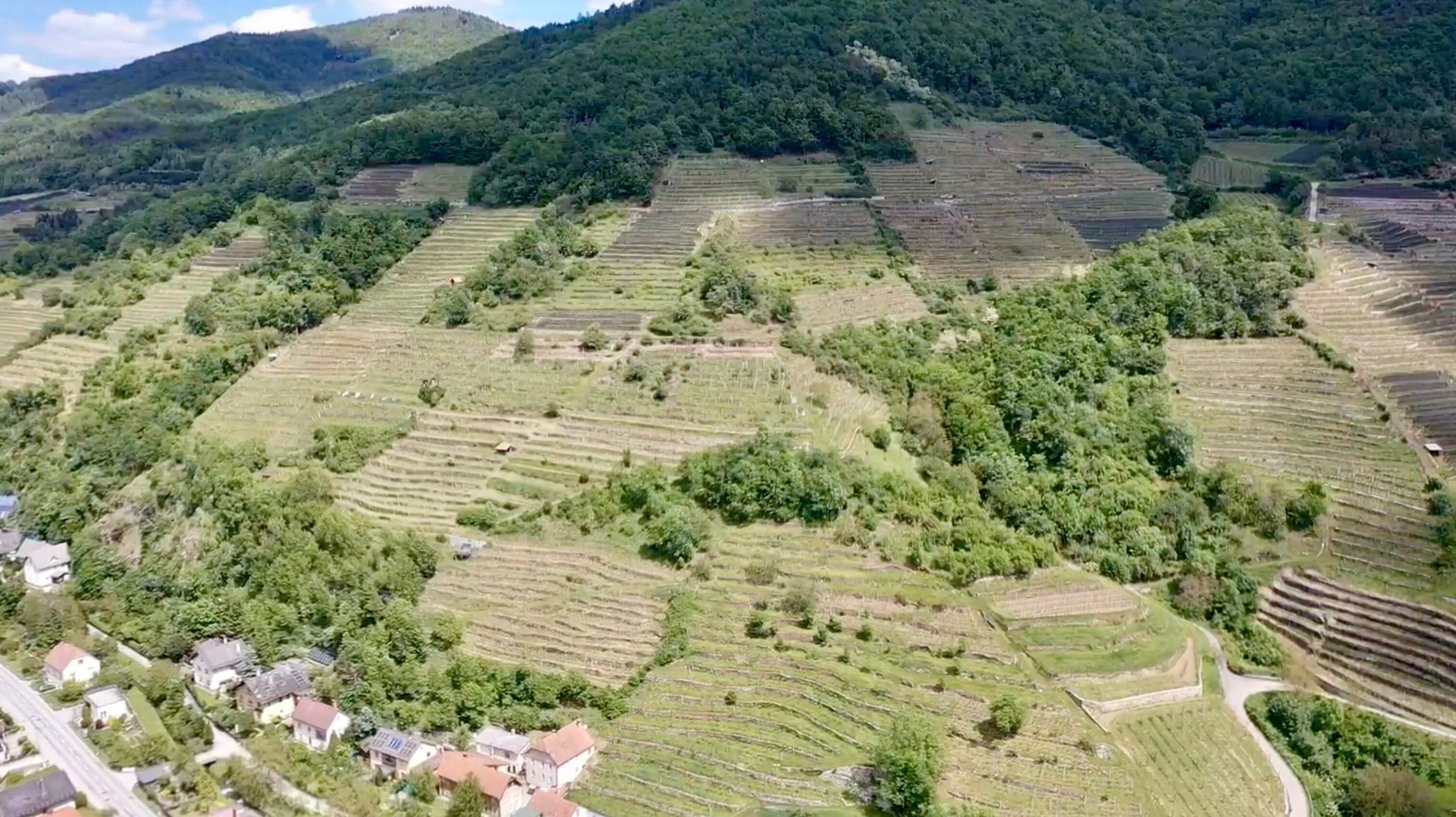
Ried Brandstatt has become a staple vineyard between the top growers in Spitzer Graben. Today (2024), several unplanted or abandoned parcels are still interspersed between sections on the southern side, allowing a little more of nature’s influence between the grower’s parcels. The vineyards also abruptly stop toward the bottom of the southern side where the rock resisted the force of what was once a torrentially flowing waterway (formerly the Danube!) leaving some short cliffs at the bottom, often with houses tucked underneath. The northern side of the vineyard is on a softer slope and is the last fully cultivated hillside for winegrowing on the north side of the Spitzer Graben. Their Riesling is planted between 390 to 430 meters on the south side on the steep but softer terraced slopes and the terrace rows are interplanted with the Grüner Veltliner away from the terrace walls to catch more wind, and the Riesling is closer to the rock walls for added heat. The thin topsoil here is rich in organic matter and rock and sand derived from the underlying bedrock of gneiss and mica schist. The other section of Brandstatt about 600 meters north is planted only to Grüner Veltliner at 370 to 400 meters. Here the slopes are softer but still very steep, and the topsoil is a little deeper, also rock and sand derived from the underlying bedrock of gneiss and mica schist.
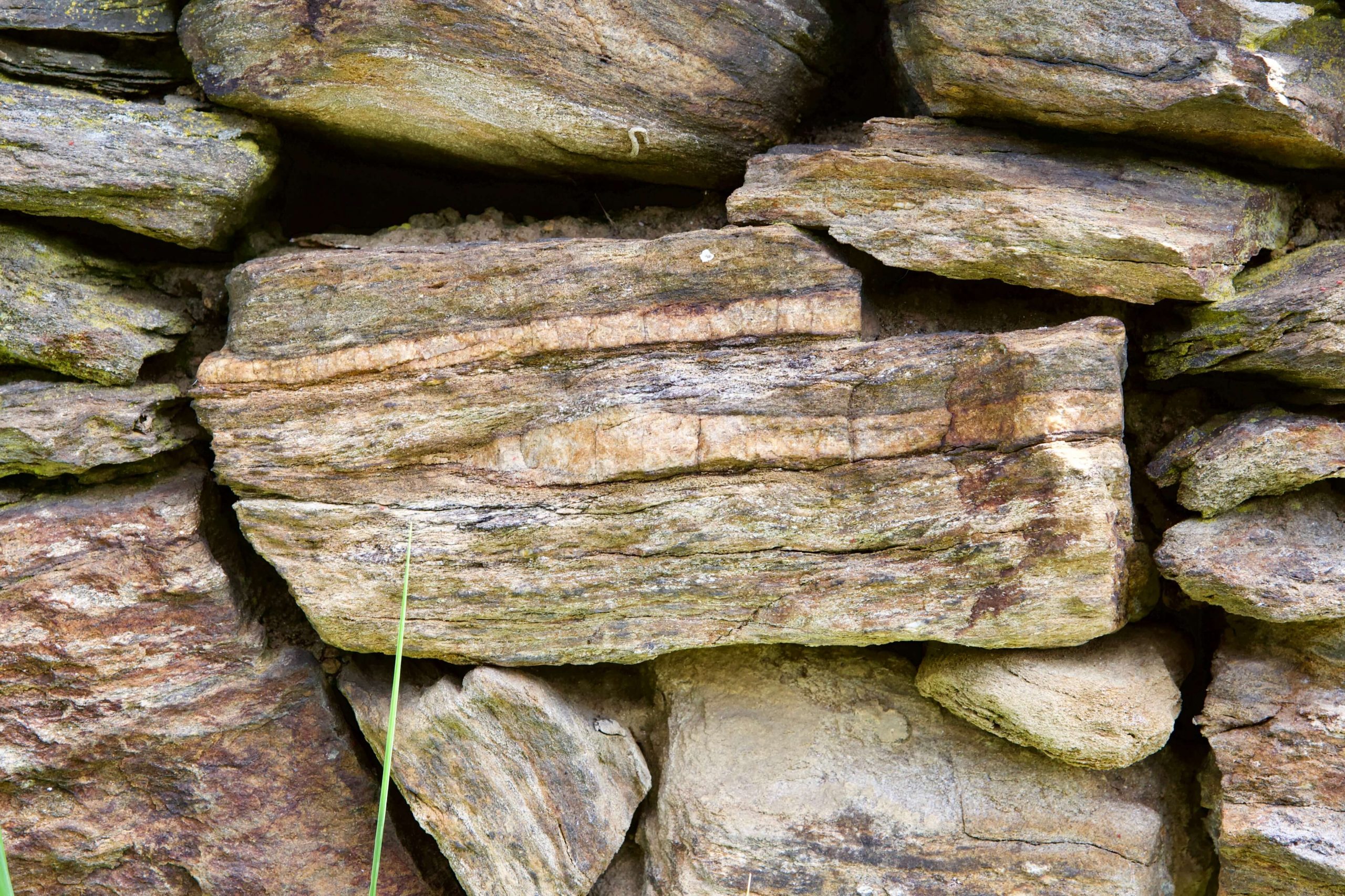

Despite the slight uptick in the last decades in overall temperature in this mountain and continental climate, the Spitzer Graben and the rest of Wachau are still on the edge between sublime weather and disaster. What keeps the Spitzer Graben cranking out world-class wines is not just the area’s natural talent for racy wines, it’s also the practice of conscious organic farming tailored to this unique environment and each plot. It’s an extremity of the Wachau, but like a lot of the region’s steep terraces with sparer topsoil and various metamorphic bedrock types from the thousands and millions of years of erosion and the Danube’s carving of the valley and the uncountable small waterways, growers look for nature’s balance in each vine rather than each plot or area. The natural crop load can be significantly higher in warmer Wachau areas and those with deeper topsoil. In Spitzer Graben, growers who have parcels with little to no soil inputs often let vines produce what they will when the fruit set has already reached the limit of the vine’s natural capacity in this slightly more extreme environment. Climate change has been good for the fruit’s ability to reach ripeness here, but the yield on its steep slopes is less than in other Wachau areas.
The Spitzer Graben’s rolling and windy landscape of steep south and west-facing terraces lined with Riesling and Grüner Veltliner is perfect for those who prefer their grapes slowly matured to reach a potential of 12-12.5% alcohol at their peak, without the need to dehydrate them a little on the vine; many members of the Vinea Wachau need to do this (at least they did in the past) to achieve Smaragd ripeness and the fullness that’s often expected of this classification.
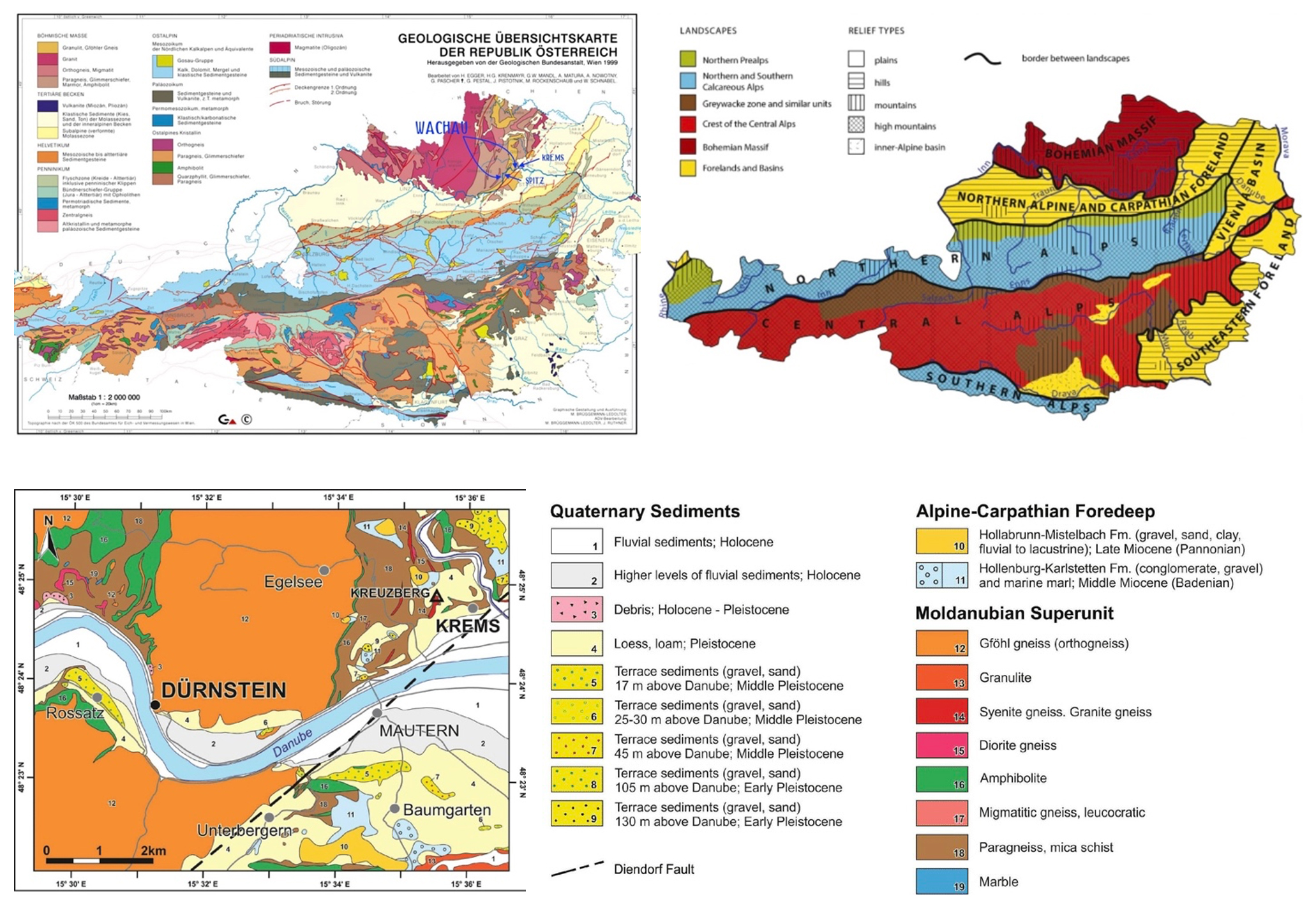
Most famously in this most southern part of the Bohemian Massif is the fabled crystalline rock, gföhl gneiss (named after a town just north of the Wachau, Gföhl), a metamorphic orthogneiss derived from igneous rock protoliths, like granite and/or granodiorite. But there are many other rock types along the Wachau River gorge such as the metamorphic rocks amphibolite, paragneiss (derived from sedimentary rocks, where orthogneiss is altered from igneous rock), quartzite and mica-schist, the latter of which seems common in Spitzer Graben. Then there’s the highly water-retentive, wind-blown, fine, silty sediment resulting from the glacial grinding of rock called loess (löss, in German), often with a high calcium carbonate content in these parts, which is also common but less so in Spitzer Graben compared to vineyards along the Danube. The Spitzer Graben’s dominant vineyard areas are steeper on average than the main pathway of the Danube, and this wind-dancing mineral-rich material blankets about 10% of the Earth’s surface. It’s often deposited on eastern-facing vineyards along the Wachau as these mineral-filled winds blew in from the north and northwest out of the Alps (though I’ve read in other sources that it may have come from the east?), and found their resting place mostly on the east faces of the terraced hills as well as the lower sections of almost every vineyard and flat zone not washed out by the Danube’s occasional flooding. In those flood areas the soil is mostly composed of gravel, sand, silt and clay, and often renders wines of lower complexity and quality.
Wines grown on loess compared to ancient metamorphic rock and topsoil present a very different growing condition. Grüner Veltliner and its big bunches need constant coddling and have a big appetite for water and nutrient intake, making loess its preferential partner. However, many compelling Grüner Veltliners are grown on metamorphic rock and are therefore quite different!
It’s in the hard, unforgiving and spare metamorphic rock where Riesling suffers more and its naturally smaller clusters yield better results for more complex wines—at least that’s what we’re told. But when the winegrower’s farming and cellar work are so impactful to a final wine’s characteristics, can anyone really make sense of the differences between how a Riesling grown in different soils derived from similar metamorphic rocks like gneiss, schist, amphibolite, and quartzite commonly found in Wachau can smell, taste and feel? It’s hard … Ask some growers and their eyes glaze over. Others are more confident. But after traveling for many years with a few different geologists in the European wine areas where we work, what is regularly missing is that, beyond a basic idea, growers often don’t really know exactly in which kind of bedrock and topsoil their vines grow. So how can this be useful, let alone be consistently observable with accuracy if we’re accidentally fed the wrong information?

Of course, it may not be the rock itself that’s the definitive influencer, as it’s not like the vine is a straw slurping directly from a rock’s guts. But indirectly, the bedrock may be one of the crucial governing factors for how a wine could feel and taste different from another grown in a different type. How each rock weathers is determined by its mineral makeup because each mineral erodes at a different rate. They also erode into different soil grains, like gravel, sand, silt and clay. The soil grain directly influences the topsoil’s water retention which has an immense influence on a wine’s characteristics: gravel, with its coarser grain, is the least water retentive, and clay, the finest of grains, the highest capacity for water retention. The mineral structure of a rock determines its hardness and what gifts it more readily imparts, or not, through erosion. And maybe that soil derived from the bedrock might not even stick around, especially on these super steep terraces. In the very steep hills of any higher altitude wine-growing region on terraces, it may be that much of the soil is only fractionally derived from the bedrock but a lot more from organic matter, some kind of glacial or river deposit. Or, sometimes growers have historically brought dirt up from lower-lying areas (a common practice that makes many terroir aficionados cringe) to give more needed soil for growth—just like we would do our gardens that have been washed out.
While Vinea Wachau’s geological research is thorough, the growers we work with in Spitzer Graben have cited mica schist as a dominant bedrock/soil type in their vineyards. This metamorphic rock generally erodes easier than gneiss as its mineral composition and structure naturally make it softer. It’s a 4 to 5 on the 10-point Mohs scale of hardness; 1 being the softest, 10 being the hardest—talc is a 1, diamond a 10. It’s softer partially because it contains the super flaky mineral, mica, which is a 2.5 to 3 on Mohs—like gold, silver, copper and, believe it or not, your fingernails! Mica schist has excellent drainage because it erodes into fine, flaky particles (the mica parts) and a sandier (quartz parts), loamier grain—ideal for Riesling quality. However, this good drainage makes it hard for young vines to grow because of its lack of water retention.
Taking its name from the Middle Ages German word, “gneist,” which means “spark” because of its reflective minerals, geologists classify gneiss as a high-grade metamorphic rock; schists are medium grade; slates are low grade. This high-grade classification implies that without completely liquifying into magma, this rock formation underwent the most tremendous rock and metal-melting heat (greater than 600°C), and immense pressure (greater than two kilobars) deep below the Earth’s surface. (One kilobar of pressure is felt at about two miles under the earth’s surface, two kilobars about four miles, and so on. We know 600°C/1112°F is crazy hot. Lava temps usually range between 700 to 1200°C—1,300 to 2,200°F.) Gneiss is hard, between 6 and 7 on the Mohs scale depending on its mineral composition, which means it traveled a long road to erosion (a good title for a geological documentary?). Gneiss has patterns where minerals were remelted under extreme heat and pressure, consolidating to form long bands of mineral layers (foliations) easily observable to the naked eye. Because this orthogneiss’ protolith was granite/granodiorite, it has the same minerals (feldspar, quartz, mica), but they’ve been partially melted and reconsolidated into mineral bands, whereas the mineral matrix of granite and granodiorite is more “pooled” into equigranular structures (meaning that some of the main mineral crystals are nearly the same size and arranged like dots inside the rock). Vine root systems will naturally follow the line of least resistance in their search for water, which if not so available in the topsoil, will work through the softest mineral because they’re the first to erode. Our growers explained that the topsoil beds on top of gneiss and derived from gneiss are often deeper and easier for the vines to grow. if it’s been planted on metamorphic rock, Grüner Veltliner naturally prefers gneiss over mica schist. Perhaps in theory, wines from this gneiss environment are somewhat richer and more powerful than those grown in softer mica schist because mica schist erodes into more sandy soils.
Why doesn’t anyone in the wine business talk about the badass rock, amphibolite? Maybe because the prefix evokes the sensation of a slimy amphibian? Amphi originates from Greek, and means “both,” or “on both sides,” or “ambiguous,” or “doubtful.” The root word, bol, comes from the Greek “ballein,” meaning throw. While the slimy creatures took this prefix because they can live in and out of the water, amphibolites were named by a French mineralogist because they are rocks of complex and variable chemical composition and crystalline structure that makes them sometimes difficult to classify. This rock is usually related to volcanic rocks, and often as a result of metamorphosed basalt and/or gabbro—two super hard (badass) rocks: 5-6 on the former, 6-7 on the latter. Why should we care about this rock type? Because it can theoretically produce powerhouse wines. When it decomposes, the breakdown of its high content of feldspar can produce kaolinite or smectite clay minerals and also have more iron oxide, among other minerals in smaller proportions. What is commonly observed in wines from grapes grown in clay and/or iron oxide, like much of the Côte d’Or’s red wine soils, or Mosel’s red slate, or Rioja and Ribera del Duero, is that they tend to impart more power. (There’s an infinite supply of rocks to turn over. To be continued …)



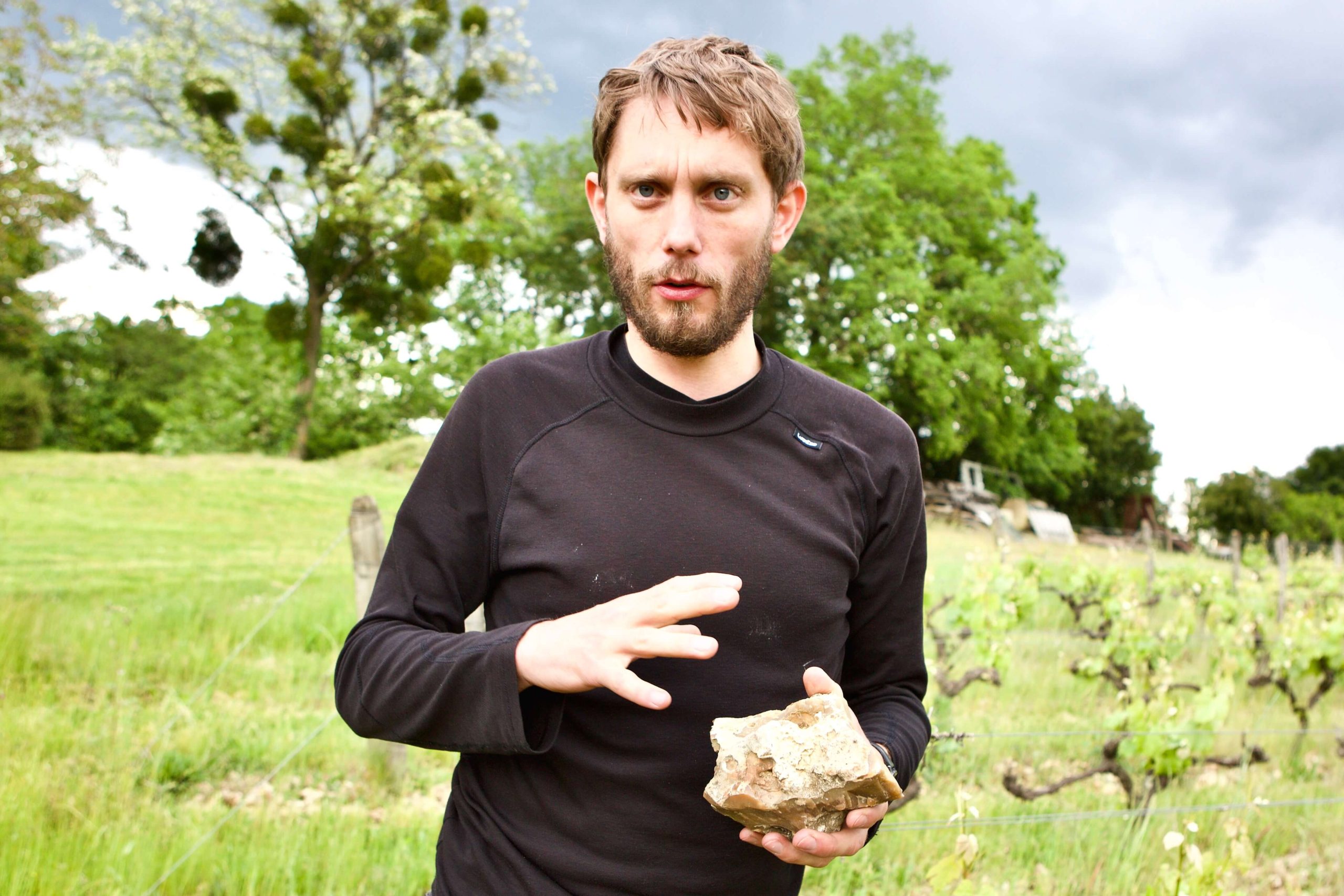
After refining his craft in celebrated vineyards and cellars of Burgundy, the Northern Rhône, and Bandol, and completing harvests in New Zealand and Australia, twenty-seven-year-old Thomas Frissant returned in 2019 to his family’s fourteen hectares in the Touraine Amboise appellation. Perched just twenty-five kilometers east of Tours, one kilometer south of the Loire River above the floodplain commune of Mosnes, he immediately embraced organic viticulture by converting his clay and silex plots, planted between the 1940s and 1990s with Sauvignon, Chenin, Chardonnay, Gamay, Grolleau, and Côt, achieving certification by 2022. Thomas now crafts wines with precision—unpretentious yet impeccably made. Anchored in these quiet yet storied terroirs of the Loire, his range offers clear and honest expressions of this historic enclave.

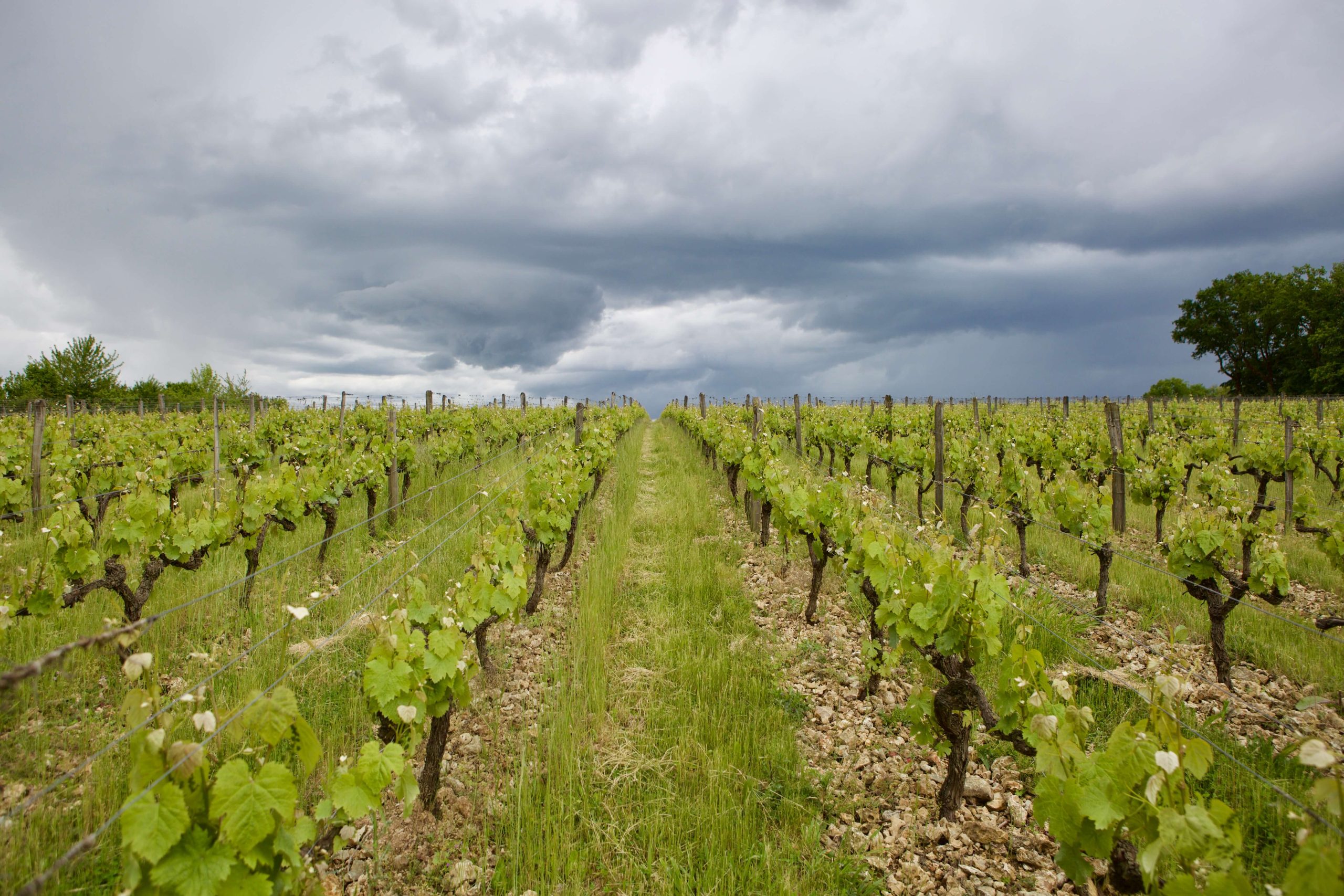
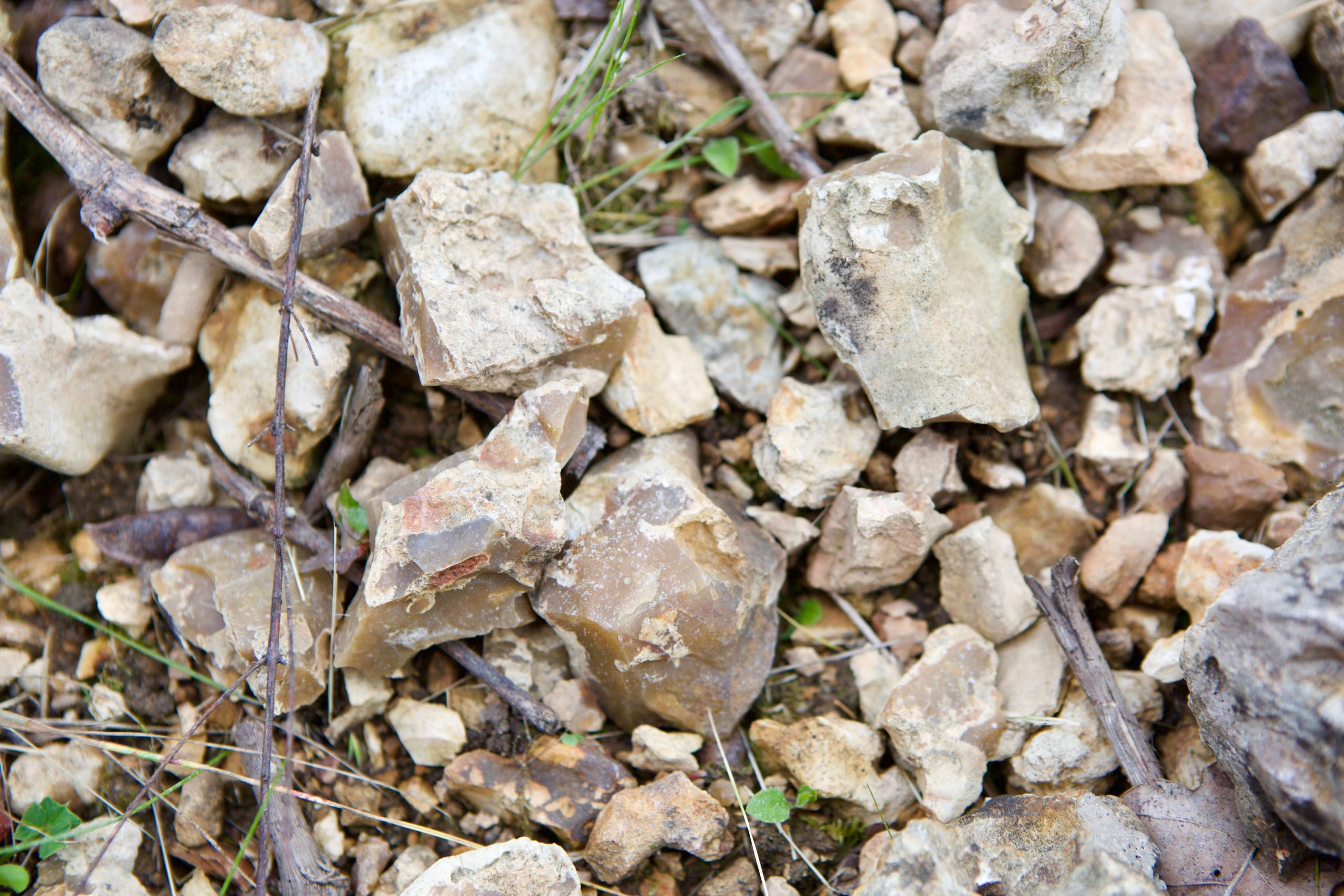
Chardonnay, ‘Tout En Canon’ is harvested from 25-year-old, east and west-facing vines on a gentle slope of flint and clay bedrock with flint rock, clay, and sand topsoil at 105 meters altitude. In the cellar it ferments for 2 weeks at a maximum of 18°C in steel. It’s aged 3 months in steel and is filtered before bottling without fining.
Sauvignon Blanc, “Le Chapeau Comte” is harvested from 20-25-year-old, east-facing vines on a gentle slope of flint and clay bedrock with flint rock, clay, and sand topsoil at 95 meters altitude. In the cellar it ferments for 2 weeks at a maximum of 18°C in steel. It’s aged 3 months in steel and is filtered and bentonite fined before bottling.
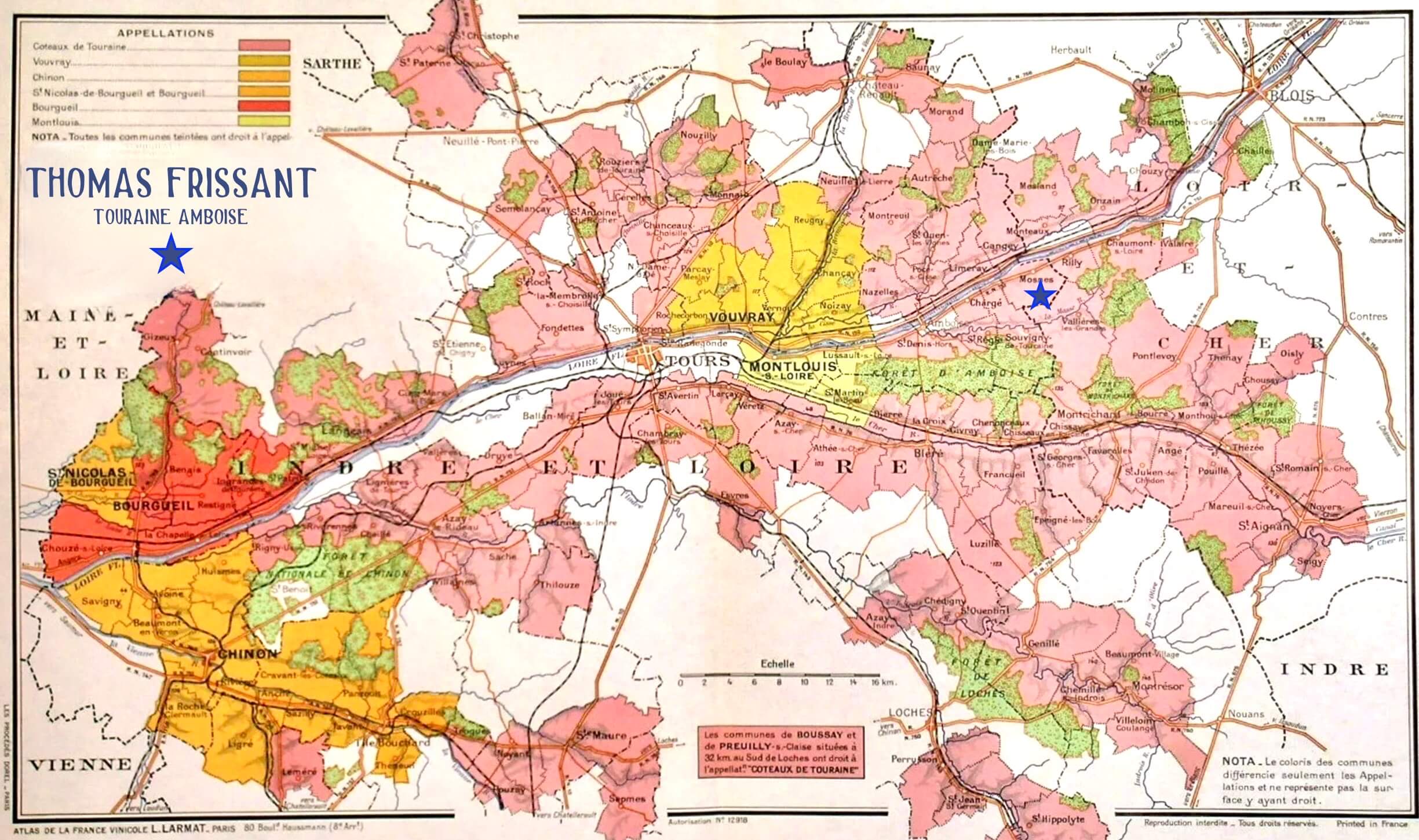
Chenin Blanc, ‘Les Perruches’ is harvested from 45-80-year-old, east-facing vines and a plot of 100-year-old vines facing northwest on gentle slopes of flint and clay bedrock with flint rock, clay, and sand topsoil at 95-100 meters altitude. In the cellar it ferments for 2 weeks at a maximum of 18°C in steel. It’s aged 8 months in steel and is filtered before bottling without fining.
Gamay, ‘Tout En Canon’ is harvested from 45-year-old, east-facing vines on a gentle slope of flint and clay bedrock with flint rock, clay, and sand topsoil at 95 meters altitude. In the cellar it’s fermented for one week at a maximum of 20°C in steel. It’s aged 5 months in steel and is filtered before bottling without fining.


